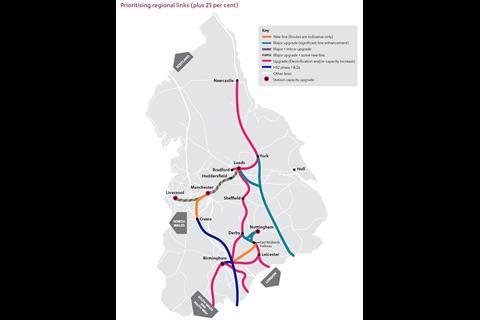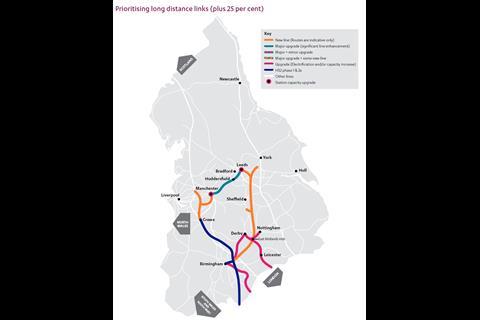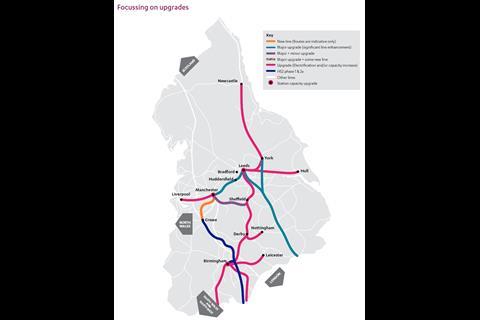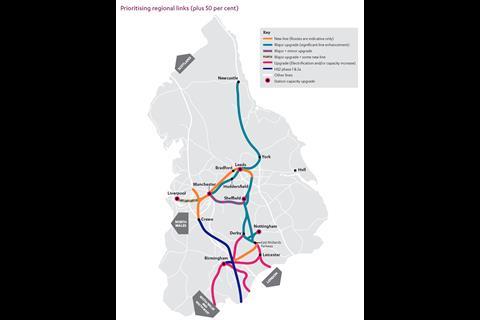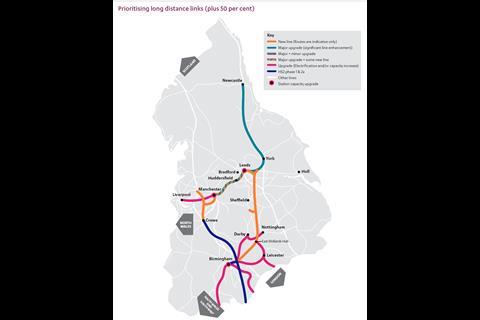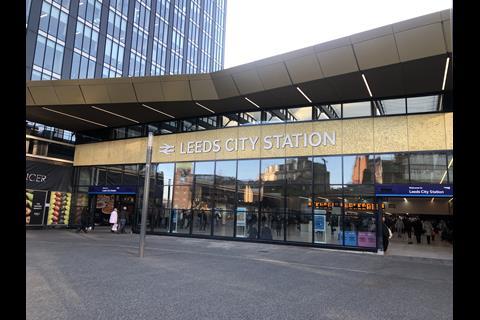UK: The National Infrastructure Commission has released its final report into the rail needs of the Midlands and north of England, commissioned by the government to inform the development of an Integrated Rail Plan.
In the report published on December 15, NIC calls for a commitment to a ‘core pipeline for investment’ to provide stability and confidence. For reasons of affordability it proposes cutting back or delaying many schemes, including at least the Sheffield – Leeds part of High Speed 2 Phase 2b and the construction of a new Northern Powerhouse Rail line.
Three budgets
The report says the current estimated cost of HS2, Northern Powerhouse Rail, the Transpennine Route Upgrade, Midlands Engine Rail and other related projects in 2020-45 is £140bn to £185bn at 2019-20 prices. NIC said this is in excess of existing cost envelopes, and securing such funding when public finances are under considerable strain ‘is not realistic’. The report notes ‘there is a long history of overspends and cost increases on major rail projects’, and suggests that the government’s plan ‘should not overpromise’.
NIC has developed packages of rail investments fitting within three illustrative budgets:
- Baseline (£86bn) using a fiscal envelope consistent with the rail spending proposed in the National Infrastructure Assessment’s fiscal remit table;
- Baseline +25% (£108bn);
- Baseline +50% (£129bn).
NIC notes, however that even the +50% budget is still not enough to deliver all the proposed schemes.
Five packages of projects
Within these budgets NIC has developed five packages of rail investments.
One focuses on enhancements in line with the spending in the fiscal remit table in the National Infrastructure Assessment; two packages are in line with spending +25%, one prioritising regional links and one prioritising long distance links; and two +50% packages also prioritise regional or long distance links.
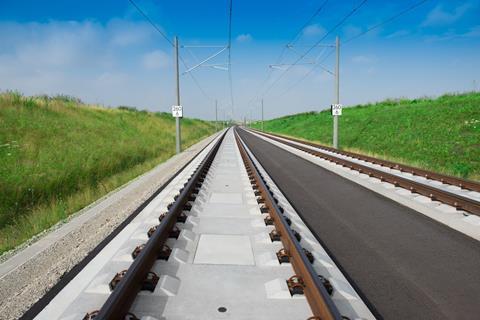
NIC says economic outcomes in the Midlands and the north are lagging behind those in the South, and ‘there is also a considerable difference between journey speeds in the Midlands and the north, and similar journeys in other countries and in southern England.’
It said local rail services suffer from poor reliability and overcrowding, and research has shown that improvements in connectivity and capacity are valued higher than ‘faster trains’, which were ranked eighth out of a list of 12 priorities.
The Commission’s analysis suggests that investments prioritising regional links are likely to have the most potential benefits. These are likely to deliver the highest benefits for productivity, as they can support higher densities in city centres. It also says ‘the package focusing on upgrades is unlikely to meet the strategic objective of levelling up in the north and the Midlands. The benefits it delivers are not at scale and would be less likely to trigger long term economic transformation than other packages.’
In order to focus on what rail is most effective at — moving people between cities and into dense city centres from the surrounding area — NIC has identified eight strategic inter-city rail routes to form the basis of the packages:
- Birmingham – Manchester;
- Leeds – Manchester;
- East Midlands – West Midlands;
- East Midlands – Yorkshire;
- Liverpool – Manchester;
- Sheffield – Leeds;
- Sheffield – Manchester;
- Leeds – Newcastle.
These corridors are also where the most significant decisions need to be made, and NIC has considered options for each corridor, including new lines, major route modernisation schemes and other upgrades.
The report says that the section of HS2 Phase 2b between Sheffield and Leeds has a low priority.
The proposed new NPR route only features in the final option for development, and even then only includes a new line from Manchester to Leeds via Bradford, with no consideration of a Liverpool – Manchester route as it takes the view that capacity can be managed via upgrading existing lines.
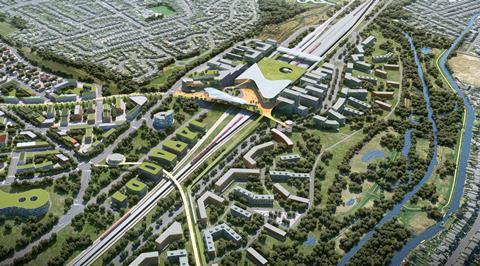
The report questions the viability of the proposed East Midlands Hub in Toton, commenting ‘under different scenarios, it is less clear to the Commission that a hub station at Toton would still be the right solution for improving connectivity across the Midlands’. It proposes that ‘an alternative option for consideration would be to improve the existing East Midlands Parkway station next to the Ratcliffe Power Station site, which was previously considered for the eastern leg of HS2.’
NIC says that while its analysis suggests that the highest local economic benefits are likely to be delivered by initially prioritising regional links, ‘this does not rule out the further development of options such as the HS2 Phase 2b full eastern leg that also have strategic value’.
It adds ‘whichever package of rail schemes the government chooses to deliver in the Integrated Rail Plan, the benefits from many of the schemes may not be seen until the 2030s or 2040s under current plans. Government should systematically consider how to accelerate major schemes and ensure it delivers benefits in the short to medium term.’
Robust reaction
Initial reaction to the announcement was robust. Particular anger came from bodies affected by any changes to plans for HS2, who had been encouraged by the Oakervee Review’s recommendation in February that the government should recommit to the full Y-shaped network.
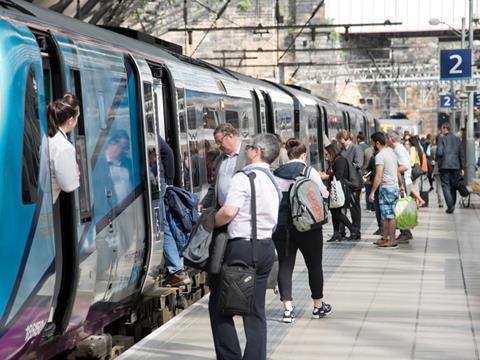
‘Constraining spending and ambition will lead to cut-price versions of the current plans and promised projects simply not being delivered — that will curtail investment in the north and cost many jobs’, said Barry White, Chief Executive at Transport for the North. ‘We now strongly urge the government to be ambitious in its decision-making. If the mission is to “build back better”, then the message is simple: commit to the options that deliver true transformation for the north. That includes better connections for communities such as those in Liverpool, Bradford, Sheffield, Hull and the North East; proper and reliable east and west links; and exploring ways to accelerate construction of projects including the full HS2 network.’
Cllr Susan Hinchcliffe, Chair of the West Yorkshire Combined Authority and Leader of Bradford Council, said ‘the limited remit of the National Infrastructure Commission means its report is based on a set of narrow considerations that fail to address the broader implications for our transport network and economic ambitions.’

Cllr Judith Blake, Leader of Leeds City Council, said ‘we have set out an ambition for a minimum of two trains per hour to serve every West Yorkshire rail station with up to six per hour on major routes, as part of an integrated transport system. HS2, Northern Powerhouse Rail with a new line from Manchester to Leeds via Bradford city centre, in addition to the upgrade in full of the trans-Pennine line, are all needed to provide the capacity that supports this vision.’
Labour’s Shadow Transport Secretary Jim McMahon said ‘if the government is serious about improving British infrastructure, supporting jobs and improving connectivity in the north it cannot now row back from building HS2 in its entirety.’
Railway Industry Association CEO Darren Caplan welcomed the call for a consistent programme of investment and ending ‘boom and bust’ work profiles, saying it was ‘vital we deliver HS2, Transpennine Route Upgrade, Northern Powerhouse Rail and Midlands Engine Rail in full, whilst also delivering decarbonisation and digitalisation across the region’s rail network.’
Rail Forum Midlands CEO Elaine Clark said ‘our rail supply chain will understandably be very concerned that all the promises of opportunities to work with HS2 will be significantly scaled back. If we are to build back better and greener then HS2 must connect our region to Yorkshire and beyond.’
Maria Machancoses, director of Midlands Connect which represents local authorities and businesses in central England, said ‘some of the options in this report are very concerning. Sacrificing parts of the high speed network now would short-change millions of people across the Midlands.’
She emphasised that ‘a decade of planning has gone into making Toton not only HS2’s East Midlands Hub, but also the site of thousands of new homes, a new centre for renewable energy and an innovation campus’. East Midlands Parkway ‘would create fewer jobs, attract less investment and stifle regeneration’, and ‘going over this old ground once again is a waste of time and resources — we need to get building now.’

